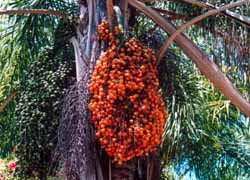
 Believe it or not, every year many flying-foxes are injured or killed by cocos palms. The cocos palm, also called queen palm (syagrus romanzoffiana) is actually a South American native, and not native to Australia, but is popular in gardens and streets around the world for its tropical look. In my early twenties, I managed our family wholesale palm nursery cocos palms were the biggest seller at the time. In Australia now, however, it is now regarded as an environmental weed due to its rapid spread into bushlands and harmful effect on native wildlife. Tree-lopping businesses report increasing work to cut down and remove cocos palms from gardens because of their high-maintenance costs. They drop seeds and fronds, drip sticky juice, are a breeding haven for cockroaches and of course attract flying-foxes, which can be deadly.
Believe it or not, every year many flying-foxes are injured or killed by cocos palms. The cocos palm, also called queen palm (syagrus romanzoffiana) is actually a South American native, and not native to Australia, but is popular in gardens and streets around the world for its tropical look. In my early twenties, I managed our family wholesale palm nursery cocos palms were the biggest seller at the time. In Australia now, however, it is now regarded as an environmental weed due to its rapid spread into bushlands and harmful effect on native wildlife. Tree-lopping businesses report increasing work to cut down and remove cocos palms from gardens because of their high-maintenance costs. They drop seeds and fronds, drip sticky juice, are a breeding haven for cockroaches and of course attract flying-foxes, which can be deadly.
Flying-foxes hanging around your cocos palms (no pun intended) can be extremely noisy and drop bat poo on everything. But don’t blame the flying-foxes – blame the cocos palms and do yourself and your neighbours a favour – cut down your cocos palms and help our environment. At the very least, if you do like cocos palms, just make sure you remove the fruiting seed bunches, which attract flying-foxes. It’s hard to believe, but along with changing climatic conditions, drought, cyclones, prolonged rainfall and food scarcity, one of the reasons our flying-fox populations are in rapid decline is because of cocos palms.
Remember: NO PALM – NO HARM
If you find an injured or sick flying fox or any bat, please contact the Bat Rescue Hotline urgently on 0488 228 134 and for more info please visit www.bats.org.au
